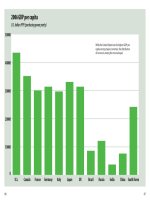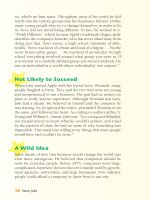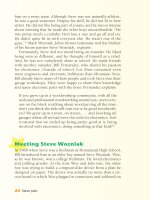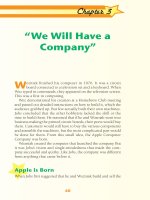Steve Jobs.Other books in the People in the News series phần 3 doc
Bạn đang xem bản rút gọn của tài liệu. Xem và tải ngay bản đầy đủ của tài liệu tại đây (619.24 KB, 10 trang )
20
Steve Jobs
him on a swim team. Although Steve was not naturally athletic,
he was a good swimmer. Despite his skill, he did not fit in here
either. He did not like being part of a team, and he was so intense
about winning that he made the other boys uncomfortable. “He
was pretty much a crybaby. He’d lose a race and go off and cry.
He didn’t quite fit in with everyone else. He wasn’t one of the
guys,”
13
Mark Wozniak, Jobs’s former teammate and the brother
of his future partner Steve Wozniak, explains.
Fortunately, Steve did not mind being an outsider. He liked
being seen as different, and he thought of himself as a rebel.
And, he was not completely alone at school. He made friends
with another outsider, Bill Fernandez, who shared his passion
for electronics. Outside of school, Los Altos contained even
more engineers and electronic hobbyists than Mountain View.
Bill already knew many of these people and took Steve into their
garage workshops. They were happy to share their knowledge
and spare electronic parts with the boys. Fernandez explains:
If you grow up in a woodworking community, with all the
tools and professional woodworking around you, and every-
one on the block is talking about woodcarving all the time,
don’t you think the kids will turn out to be good woodwork-
ers? We grew up in a town, on streets, . . . and [working in]
garages where all we had were the tools for electronics. Isn’t
it natural that we ended up being pretty good at it, being
involved with electronics, doing something in that field?
14
Meeting Steve Wozniak
In 1968 when Steve was a freshman at Homestead High School,
Bill introduced him to an older boy named Steve Wozniak. Woz,
as he was known, was a college freshman. He loved electronics
and pulling pranks. At the time Woz and Jobs met, the older
boy was trying to build a computer-like device from a plan he
designed on paper. The device was actually no more than a cir-
cuit board to which Woz plugged in connectors and soldered on
A Difficult Start
21
microchips. It worked by following a program written on a punch
card, which slid into the device. The program made it light up
and beep every few minutes.
Fernandez, who was Woz’s neighbor, helped him build the
device, which eventually blew up. He wanted to show the
machine to Jobs, as well as introduce him to Woz. From the
start, the two Steves hit it off. Woz recalls:
I remember—Bill called Steve and had him come over to
his house. I remember Steve and I just sat on the sidewalk
in front of Bill’s house for the longest time just sharing
stories—mostly about pranks we’d pulled, and also what
kind of electronic designs we’d done. . . . So Steve came
into the garage and saw the computer (this was before it
The Transistor
T
he invention of the transistor changed electronics. It,
more than anything else, made the personal computer
possible.
A transistor is a tiny electronic device that uses silicon to
conduct the flow of electricity. Silicon keeps electricity flow-
ing in one direction, which is why transistors are also known
as semiconductors.
Before transistors were invented large vacuum tubes were
used to conduct the flow of electricity. Early computers,
which were gigantic, contained thousands of vacuum tubes.
Replacing vacuum tubes with transistors meant that elec-
tronic devices, including computers, could be made smaller.
Pocket-sized radios were one of the first products to use tran-
sistors. Today almost all electronic devices contain transistors.
Microchips, which serve as the brains of computers, are basi-
cally pieces of silicon embedded with thousands of transis-
tors.
William Shockley, John Bardeen, and Walter Brattain invent-
ed the transistor in 1947. The men won the Nobel Prize for
their invention in 1956.
22
Steve Jobs
blew up) and listened to our description of it. I could tell
he was impressed. I mean, we’d actually built a computer
from scratch and proved that it was possible—or going to
be possible—for people to have computers in a really small
space. Steve and I got close right away, even though he was
still in high school.
15
Nothing Stood in Jobs’s Way
It did not take long for the two Steves to become close friends.
Working on projects with Woz and Fernandez increased
Steve’s passion for electronics. He joined the electronics club at
Homestead High School, as well as Hewlett Packard’s Explorer
Club, which offered monthly lectures for young people interested
in electronics. It was at one of these lectures where Jobs saw his
first real computer. He was fascinated by it and vowed he would
own one in the future.
At another Explorer’s session, Steve became interested in holo-
graphics, a method of producing three-dimensional photographs
using laser beams. After the session, he waylaid the lecturer and
bombarded him with questions. According to Young and Simon,
Steve “had an intensity, driven by whatever his latest passion
might be. He would stand very close to whomever he was talk-
ing to, invading the person’s space as he poured forth about his
newest discovery, and he was nearly impossible to avoid once he
made up his mind to buttonhole you.”
16
Steve was so passionate about the subject that the scientist
agreed to take him on a private tour of the company’s holographic
laboratory, which was not typically done for private individu-
als. Then, when Steve got home he called up Bill Hewlett to ask
him for spare holographic parts, so that he could build his own
holographic device. Hewlett was one of the founders of Hewlett
Packard. He was a very important man, and a perfect stranger to
Steve. It would not have been surprising if Hewlett had hung up
on him. Even then, Jobs was so persuasive that Hewlett not only
had a long conversation with the boy, he provided Steve with the
A Difficult Start
23
Steve Wozniak was brilliant with electronics and quickly
became Jobs’s friend.
24
Steve Jobs
parts he wanted, and gave him a summer job working for Hewlett
Packard. Jobs recalls:
He was listed in the Palo Alto phone book. He answered the
phone and he was real nice. He chatted with me for, like,
twenty minutes. He didn’t know me at all, but he ended
up giving me some parts, and he got me a job that sum-
mer working at Hewlett-Packard, on the line assembling
frequency counters . . . Well assembling may be too strong.
I was putting in screws. It didn’t matter. I was in heaven.
17
A Business Man
Steve could not ask for donated parts for his next project because
it involved building an illegal device known as a blue box with
Woz. It allowed users to make free long distance telephone calls.
To help finance the project, Jobs took a part-time job at a local
electronics store. He learned a lot about the value of electronic
parts while working there. In fact, he became so knowledge-
able that he started buying underpriced parts at flea markets and
reselling them to his boss at the electronics store for a profit.
This was Jobs’s earliest experience as a businessman, and he
liked it. So, once the two Steves had managed to build one blue
box, Jobs proposed that they build more and sell them at Berkeley
where Woz was attending college. Woz’s original intention was
to build just one blue box, which the boys would use to pull
pranks. In fact, they did have fun with the box. They called
the Ritz Hotel in London and made reservations for dozens of
nonexistent people. Another time, they called the pope at the
Vatican. Although making mischief was enough for Woz, it was
not enough for Jobs. He saw a chance to make money and con-
vinced Woz to take part. Kaplan explains:
Woz . . . liked the intellectual challenge of creating some-
thing and of understanding the way things worked. Jobs, by
contrast, seemed to see electronics as a means to an end . . .
A Difficult Start
25
For Woz, the fun was in the chase; he once told an inter-
viewer that in playing tennis, “the winning isn’t as important
as the running after the ball.” Jobs just wanted to win, and
better yet, to sell all the tickets to the stadium. Woz had
no ambition. Jobs had nothing but. That desire, combined
with his freight-train intensity and golden tongue, made
Jobs formidable.
18
Both Steves contributed to the project in their own way. Jobs
got the supplies for the boxes for $40. Woz built the devices. Jobs
sold them for anywhere from $150 to $300, depending on how
much he thought the customer could afford.
As for their illegal enterprise, it came to an end after Jobs was
held up at gunpoint by a prospective buyer. But the pattern that
the two young men established of Woz building a product and
Jobs marketing it would serve them well in the future.
26
Searching for
Answers
Chapter 2
A
s a high school student, Steve embraced the counterculture
values of individuality, rebelliousness, and experimentation
with psychedelic drugs that flourished in the early 1970s. He
looked like a hippie. He had long hair, sported love beads, and
often went barefoot. At the same time, he was somewhat of a
nerd. He was passionate about electronics, developed an interest
in poetry and creative writing, and was as intense as ever.
It was at this time that he became involved with Chris-Ann
Brennan, a young woman who shared Steve’s counterculture val-
ues and intellectual pursuits. The two became very close, and they
would maintain an off and on relationship for years to come.
In 1972, Steve graduated from high school. He was accepted
to many prestigious universities including neighboring Stanford,
which was famous for its engineering department and seemed
a perfect fit for him. He, however, did not want to go there.
“Because,” he explained years later, “everyone there knew what
they wanted to do with their lives. And I didn’t know what I
wanted to do with my life at all.”
19
Steve spent the next few years experimenting with different
lifestyles in an effort to figure out who he was and what he wanted
to do with his life. While Jobs was searching for enlightenment,
Steve Wozniak dropped out of Berkeley and started working for
Hewlett Packard. The two were at different points in their lives
and did not see much of each other.
Searching for Answers
27
Reed College
When it came to choosing a college, Steve opted for Reed College
in Oregon. His parents did not like this choice. The tuition was
more than they could afford. But Steve had made up his mind.
He insisted that if he could not go to Reed, he would not go to
college at all. His parents were helpless against his strength of
will. In the end, they emptied out their savings so that Steve
could have his way.
The main reason Steve selected Reed was because it was known
for its oddball students and liberal counterculture atmosphere.
According to fellow Reed student Elizabeth Holmes, “In the
early seventies, Reed was a campus of loners and freaks [eccen-
trics].”
20
Even at Reed, Jobs stood out. Robert Friedland, who became
Steve’s friend, recalls:
He was always walking around barefoot. He was one of the
freaks on the campus. The thing that struck me was his
intensity. Whatever he was interested in he would generally
carry to an irrational extreme. He wasn’t a rapper [talker].
One of his numbers was to stare at the person he was talking
to. He would stare into their . . . eyeballs, ask some ques-
tion and would want a response without the other person
averting their eyes.
21
In addition to Friedland, Steve became friends with Dan
Kottke, an intellectually gifted young man who was also trying
to find himself. But it was Friedland who had a huge impact on
Jobs. Friedland was older than Steve and was somewhat of a
celebrity on campus. Steve first noticed Friedland because the
older boy dressed in long flowing robes.
Friedland was an outgoing person who could charm almost
anyone. He was always the center of attention and was an excel-
lent salesman. He was especially good at captivating a crowd and
was handily elected the president of Reed’s student council. He
soon became Steve’s mentor.
Steve was an introvert who had trouble connecting with large
28
Steve Jobs
groups. And, because he often felt that he was smarter than almost
everyone else, he sometimes came off as arrogant, which did not
endear him to others. Steve studied the way Friedland interacted
with people and how he captivated large crowds. As a conse-
quence, Steve became more charming and better able to address
a large group. This skill served him well when he addressed
MacWorld gatherings in the future. According to Kottke,
Robert was very much an outgoing, charismatic guy, a real
salesman . . . When I first met Steve he was shy . . . I think
Robert taught him a lot about selling, about coming out of
his shell, of opening up and taking charge of a situation.
Robert was one of those guys who was always the center
Searching for Answers
29
of attention. He’d walk into a room
and you would instantly notice him.
Steve was the absolute opposite when
he came to Reed. After he spent time
with Robert, some of it started to rub
off.
22
Searching for the
Meaning of Life
Friedland also inspired Steve in his
quest for enlightenment. Indeed, before
coming to Reed, Friedland had spent
time in jail for possession of LSD. He
had experimented with the drug as part
of his own quest for enlightenment.
Steve conducted his search for
enlightenment with the same intensity
as he had conducted his electronic proj-
ects. He studied Eastern religions and
became a Zen Buddhist, a religion he
continues to practice. He tried meditat-
ing, experimented with sleep deprivation, and studied the link
between diet and physical and spiritual health. He experimented
with fasting and different diets, and campaigned for his friends
to join him on whatever diet he was currently following. At one
point, his diet consisted mainly of carrots. He ate so many that
his skin turned orange. He then became a fruitarian and took to
showering infrequently. He believed his diet would keep his body
clean. “I still believe man is a fruitarian,” he told writer Michael
Moritz years later. “Of course, back then I got into it in my typi-
cally nutso way.”
23
Eventually, he became a vegetarian and has
followed that diet throughout his life.
Jobs attended Reed College in
Oregon.









